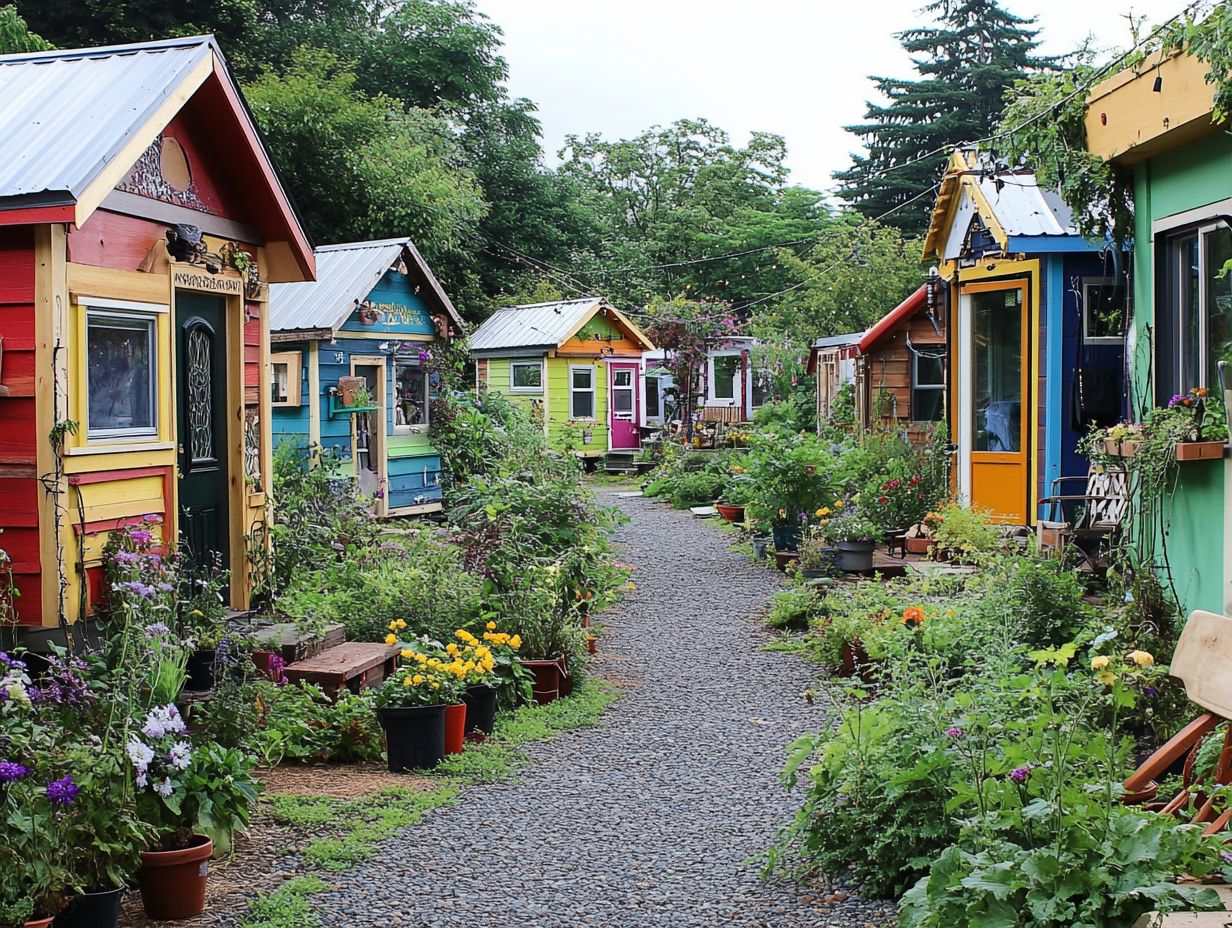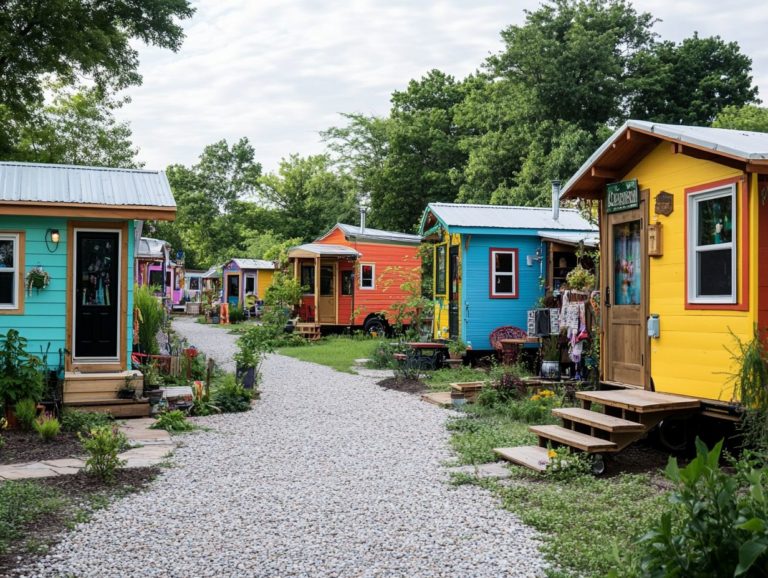The Cultural Impact of Tiny House Communities
Tiny house communities are becoming increasingly popular as more individuals seek sustainable and affordable living options.
These compact homes provide not just shelter, but also an opportunity to embrace a minimalist lifestyle and build meaningful community connections through communal living and shared resources.
Let s explore why tiny house communities are capturing hearts and minds! This discussion showcases their environmental and financial benefits, the social dynamics they foster, and the challenges they encounter.
Explore with us as we navigate this captivating trend and envision its future as a tourist destination in modern society.
Contents [hide]
- Key Takeaways:
- The Rise of Tiny House Communities
- Benefits of Living in a Tiny House Community
- Environmental and Financial Advantages
- Social and Cultural Impact of Tiny House Communities
- Challenges and Criticisms of Tiny House Communities
- Future of Tiny House Communities
- Frequently Asked Questions
- What is the cultural impact of tiny house communities?
- How do tiny house communities promote sustainable living?
- What are the benefits of living in a tiny house community?
- How do tiny house communities challenge traditional housing norms?
- What are some cultural concerns surrounding tiny house communities?
- How can individuals get involved in the tiny house movement?
Key Takeaways:

Tiny house communities are gaining popularity for their simplicity and environmental benefits.
Living in a tiny house community offers a strong sense of community and an alternative lifestyle.
Despite challenges and criticisms, the future looks bright for tiny house communities, emphasizing the importance of community support and ethical business practices.
The Rise of Tiny House Communities
The emergence of tiny house communities marks a profound evolution in housing options. This movement has been propelled by an increasing awareness of environmental sustainability and the tiny house movement, highlighting the need for more eco-friendly homes that are good for the environment.
As urban hubs such as New York City and San Francisco grapple with rising housing challenges, the allure of tiny homes celebrated for their distinctive architectural design and simplified living grows ever more compelling.
You ll find that these eco-friendly homes not only bolster personal financial well-being but also cultivate a sense of community and mutual support. This is vividly illustrated by thriving initiatives in California and beyond, showcasing the potential of tiny living to redefine lifestyles and foster connections through interdependent community engagement.
Exploring the Trend and its Popularity
The tiny house movement has gained immense popularity as many seek eco-friendly and affordable living solutions in response to urban housing challenges. This shift fosters a deeper understanding of housing supply and wealth disparity.
This surge in interest can be attributed to several compelling factors. First, environmental sustainability has become a cornerstone of modern living, with many embracing the minimalist lifestyle inherent in tiny homes to reduce their carbon footprint. The economic benefits are hard to overlook; studies show that tiny homes cost significantly less to build and maintain, making them an attractive option in an increasingly expensive housing market for those facing affordability concerns.
The tiny house movement also fosters a sense of community and emotional well-being. Residents engage in outdoor gatherings and share resources with one another. Communal living setups and tiny house villages encourage interaction and cooperation, creating bonds that transcend traditional neighborhoods and highlight the importance of sustainability in tiny house communities.
Recent studies indicate that this shift not only influences individual lifestyles but also positively impacts local economies, as tiny home developments create jobs and stimulate local businesses. Exploring unique tiny house communities around the world can provide further insight into this growing trend.
Benefits of Living in a Tiny House Community
Residing in a tiny house community presents a wealth of advantages that transcend traditional housing solutions. You ll discover improved financial health, boosted emotional well-being, and a deep commitment to sustainable living, all woven into the fabric of this unique lifestyle.
Are you ready to embrace a simpler, more sustainable lifestyle? Discover the tiny home community near you!
Environmental and Financial Advantages

The environmental and financial benefits of living in tiny homes are powerful reasons to consider this lifestyle. They encourage sustainable habits and significantly cut down on consumption while supporting the local economy.
Embracing a minimalist lifestyle helps lower your carbon footprint the amount of carbon dioxide we produce that affects the environment. Tiny homes also tackle the urgent issue of homelessness through initiatives like tiny homes for those without shelter.
Tiny homes provide a creative solution by offering shelter to those in need. Their compact design translates to lower utility costs and maintenance expenses.
This financial relief can greatly improve your financial health. It allows you to direct resources toward education or job opportunities, promoting self-sufficiency and community support.
Adopting this housing model emphasizes the importance of environmental justice. It inspires you and your community to push for policies that encourage sustainable living and fair access to housing solutions.
Social and Cultural Impact of Tiny House Communities
Tiny house communities do more than reshape the physical landscape; they greatly influence social interactions and cultural dynamics. These communities foster a sense of community support and collaboration among residents, essential for tackling housing challenges.
Community Building and Alternative Lifestyles
The focus on community building within tiny house living invites you to embrace lifestyles that prioritize working together, representation, and fair business practices. This promotes support for diversity.
By creating an environment where you and your neighbors share resources and experiences, including various skills and borrowing items, these communities nurture a strong sense of belonging and purpose.
Take Tiny Home Village in Eugene, Oregon. It shows how such communities provide affordable housing and build crucial support networks for people from diverse backgrounds, highlighting the emotional benefits of community living.
Organizations like the Tiny House Alliance advocate for ethical practices in tiny home development. They ensure newcomers feel welcome and represented while promoting community outreach.
Through engaging outreach programs, they offer workshops that empower you to take part in decision-making processes. This enriches the collaborative spirit that defines tiny house living.
Challenges and Criticisms of Tiny House Communities
While tiny house communities provide numerous benefits, they also face significant challenges and criticisms. Issues like housing accessibility, wealth disparity, and the historical impacts on marginalized populations are particularly important to consider.
These factors complicate the narrative, inviting further reflection on the true implications of such living arrangements. This includes wealth disparity and the emotional states of residents.
Addressing Concerns and Misconceptions

Addressing the concerns and misconceptions surrounding tiny homes is crucial for fostering a deeper understanding and acceptance of this growing movement.
Many people mistakenly believe these dwellings are only for those facing financial hardships or that they sacrifice comfort and quality of life. This overlooks the unique design and craftsmanship of many tiny homes.
In reality, tiny homes can be an attractive and practical option for a wide range of individuals, from environmental advocates and minimalists to families looking to downsize and embrace sustainable living.
The tiny house community actively supports engagement initiatives that promote collaboration, diversity, and inclusivity, ensuring every voice matters in shaping their living spaces. This enhances the emotional benefits of community.
By embracing a variety of experiences and backgrounds, tiny home communities create supportive environments where residents come together to tackle housing challenges and foster a real sense of belonging.
Future of Tiny House Communities
Tiny house communities are on the brink of an exciting future! They showcase innovative architectural designs and gain increased recognition as sought-after tourist destinations, particularly in areas like Mount Laguna and California. Embrace the possibilities that lie ahead in this evolving landscape, where creativity and sustainability converge to redefine living spaces and experiences.
Predictions and Potential Growth
Predictions for the tiny house movement suggest you can expect a continued emphasis on sustainable living and heightened community support as awareness of how our surroundings affect our feelings expands.
As urban dwellers like yourself explore alternatives to conventional housing models, the momentum behind tiny house communities is likely to intensify. These developments not only maximize land efficiency but also encourage a lifestyle that minimizes your ecological footprint. Additionally, tiny house communities can foster new friendships among residents.
Experts point out trends such as the integration of renewable energy solutions, energy sourced from nature that won t run out, like solar or wind power, and shared resources. This enhances sustainability and promotes advocacy for diversity in tiny home communities. Case studies from cities like Portland, Oregon reveal how these communities offer psychological benefits, fostering social interaction and alleviating stress for residents like you.
The sense of belonging and active participation in a collective environment are pivotal factors propelling this movement forward, reflecting the importance of living modestly and the impact of community support.
Frequently Asked Questions
What is the cultural impact of tiny house communities?

The cultural impact of tiny house communities refers to the effects these communities have on the social, economic, and environmental aspects of society. It includes changes in lifestyle, community dynamics, and attitudes towards minimalistic living.
How do tiny house communities promote sustainable living?
Tiny house communities promote sustainable living by encouraging minimalism, reducing the use of resources, and promoting eco-friendly practices such as composting, rainwater harvesting, and the use of renewable energy sources.
What are the benefits of living in a tiny house community?
Living in a tiny house community offers several benefits, including affordability, reduced environmental impact, and a sense of community and belonging. It allows for a simpler and more intentional way of living.
How do tiny house communities challenge traditional housing norms?
Tiny house communities challenge traditional housing norms by promoting eco-friendly and sustainable ways of living. They dispute the notion that bigger is better, aligning with the principles of minimalism and encouraging people to downsize and simplify their lives.
What are some cultural concerns surrounding tiny house communities?
Some cultural concerns include the potential for gentrification and the impact on the local economy, as well as zoning and building code regulations, which pose challenges for many communities. There may also be cultural resistance to the concept of minimalistic living and shared community spaces, which promote community support and emotional well-being.
How can individuals get involved in the tiny house movement?
Individuals can engage in the tiny house community movement by joining existing communities, attending events and workshops focused on sustainable living and shared resources, and advocating for changes in zoning and building codes. They can also support and promote sustainable living practices, community engagement, and the benefits of tiny house living, which include reducing consumption.
Join the tiny house movement now to be part of this amazing change!






